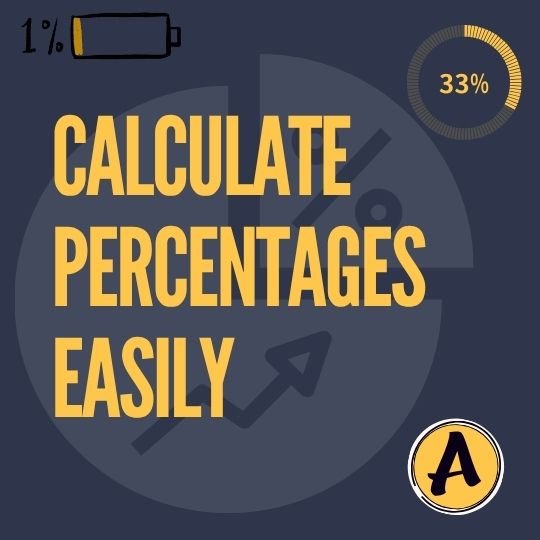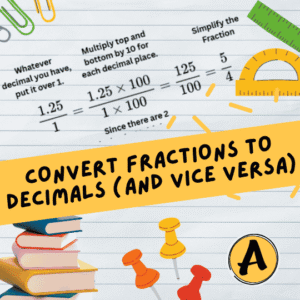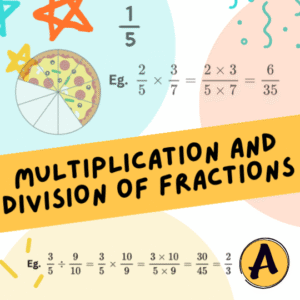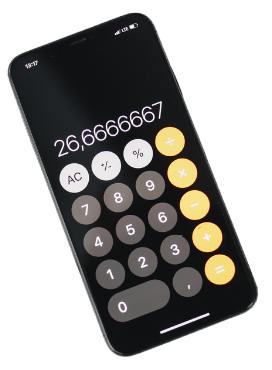📈 Calculate Percentage from Decimals & Fractions — and Vice Versa
🧩 Percentage Word Problems (Medium)
🧠 Percentage Word Problems (Hard)
🧠 What Is a Percentage?
“Percent” means “per hundred”. A percentage is a fraction with a denominator of 100.
Example: 75% means 75/100.
We have seen 50% off sign at your various stores or received an exam score of 80%. That’s a percentage — a simple way to compare parts out of 100!
Humans began using percentages because they make numbers easier to understand and compare. Instead of saying something confusing like “1349 out of 1589 students passed,” we can simply say “85% of students passed.” A percentage shows how much of something you have out of a total of 100 parts. It instantly gives a clear picture of the data, helping us grasp information quickly without doing complex calculations.
Thus, Percentages are another way to write fractions and decimals — all three mean the same thing, just in different forms.
Conversions Formulae to Calculate Percentages Easily
The key formula to calculate percentages easily is to multiply the number/fraction/decimal by 100:
a) Fraction → Percentage
Multiply the fraction by 100. Example: (3/4) × 100 = 75%
b) Decimal → Percentage
Multiply the decimal by 100. Example: 0.65 × 100 = 65%
c) Percentage → Fraction
Write the percentage over 100, then simplify. Example: 40% = 40/100 = 2/5
d) Percentage → Decimal
Divide by 100. Example: 75% = 0.75
Finding a Percentage of a Number
Multiply the number by the percentage (in decimal form).
Example: 20% of 250 = 0.20 × 250 = 50
Reverse Percentage
Used when the percentage and result are given, but the original number is unknown.
Example: 20% of x = 36 → x = 36 ÷ 0.20 = 180
Percentage Increase / Decrease
Increase: New value = Original value × (1 + Increase%/100)
Decrease: New value = Original value × (1 – Decrease%/100)
Example: Increase 200 by 15%: 200 × 1.15 = 230
Percentage Change
Percentage change = (Difference / Original value) × 100
If the value goes up → increase.
If the value goes down → decrease.
💡 Real-Life Examples of Percentages
Percentages are everywhere — in shopping, school, sports, and even money matters. Learning to calculate percentages easily helps students make smarter decisions every day.
When shopping, discounts are given as percentages. For example, if a jacket costs $100 and there’s a 20% discount, you save $20, paying only $80. Knowing this helps you quickly spot the best deals.
In school, exam marks are also shown as percentages. If you get 45 out of 50 answers correct, that’s (45 ÷ 50) × 100 = 90% — a clear way to see your performance.
Sports use percentages too. A basketball player with a 75% free-throw rate scores about 75 out of every 100 shots, making it easy to compare skills.
Percentages also appear in money and savings. Banks pay interest as a percentage of your balance — the higher the percentage, the faster your money grows.
From sales to schoolwork, understanding how to calculate percentages easily helps you make sense of numbers in everyday life.
Common Percentage Mistakes Students Make
Even when students learn how to calculate percentages easily, small mistakes can still sneak in and change the answer completely.
A common error is dividing instead of multiplying. Remember — to find a percentage of a number, you multiply the number by the decimal form of the percentage. For example, 20% of 150 = 150 × 0.20 = 30.
Another mistake is forgetting to convert percentages into decimals before calculating. Just divide the percentage by 100 to make it a decimal:
👉 25% = 0.25 👉 10% = 0.10 👉 75% = 0.75
Students also mix up percentage increases and decreases. A 50% increase followed by a 50% decrease won’t return you to the original number, because each change is calculated from a different base value.
By slowing down and checking each step, students can avoid these errors and calculate percentages confidently and correctly every time.
⚡ Quick Tips and Tricks to Learn Percentages Faster
Learning percentages doesn’t have to be hard — with a few smart tricks, you can calculate percentages easily and save time in exams or real life.
A great shortcut is estimation. To find 25% of a number, just divide it by 4, since 25% equals one-quarter. For 50%, simply find half — no calculator needed!
Another trick is to remember common percentage conversions.
👉 10% of a number = divide by 10
👉 20% = double the 10% value
👉 30% = add 10% + 20%
Breaking percentages into smaller, easy chunks makes mental maths much faster.
You can also visualise percentages using pie charts or bar graphs. Seeing how a part fits into a whole helps you understand the concept better — especially for topics like discounts or statistics.
And of course, practice makes perfect. The more you solve percentage questions, the quicker and more confident you’ll become at spotting shortcuts and applying them correctly.
With these simple strategies, you’ll be able to calculate percentages easily, accurately, and confidently — anytime, anywhere!










